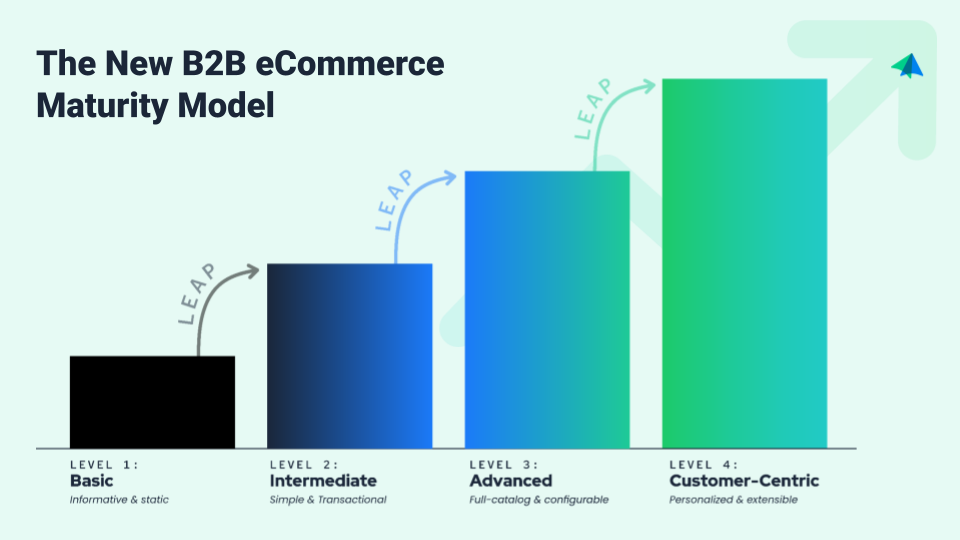B2B companies everywhere are continuing to see staggering growth in eCommerce as not just another viable sales channel, but as a strategic imperative to meet modern buyer expectations and boost revenues in the digital era. But B2B companies are all at different stages of maturity and generally fall into one of four levels of the New B2B eCommerce Maturity Model: Basic, Intermediate, Advanced, or Customer-Centric.
This four-part blog series explores each level and provides guidance on how to leap ahead with your eCommerce. This is the first post in the series, which is focused on Level 1: Basic eCommerce.
Understanding Level 1: Basic eCommerce
The first stage in our B2B eCommerce maturity model is Level 1: Basic eCommerce. This level recognizes that many companies are already dipping their toes into eCommerce or actively seeking ways to bring their products online. But what exactly characterizes Level 1?
The Hallmarks of Basic eCommerce
Level 1 is all about laying the groundwork for eCommerce and focusing on getting the basics right. Companies at this stage typically have some product information available online, albeit without the ability for buyers to self-service and transact on their own. Because the Basic eCommerce level doesn’t include transaction capabilities, the digital portion of the customer experience typically concludes with prompts such as "talk to sales," "request a quote," or "find a dealer," which show a reliance on traditional sales channels rather than eCommerce-enabled transactions.
Key Attributes of Basic eCommerce
- The digital storefront is essentially a partial product catalog.
- The experience is reliant on the buyer’s product knowledge; put another way, buyers need to know exactly which products they are looking for.
- There are no product configuration or self-service options for buyers.
- There are no direct purchasing or transaction options.
- The overall experience is focused more on providing basic information than on customer experience.
Leaping from Level 1 to Level 2
The journey from Level 1: Basic eCommerce to Level 2: Intermediate eCommerce marks a significant advancement in B2B eCommerce maturity. At Level 2, companies make the leap from purely informational websites to eCommerce experiences that enable buyers to make some purchases independently. But what does it take to make this leap?
A Commitment to Healthy, Robust Product Data
Start small by focusing on improving and optimizing product data. In order to get to Level 2 where you can start offering transaction options for buyers, you may start with your simplest SKUs or parts, your best-selling products, or the items that are easiest to sell.
A Review of Sales Team Structure and Compensation
If you’re changing the way you sell, you’ll need to adjust how you structure your resources and compensate your sellers. Because buyers will be able to directly purchase some simple products in Level 2, it will be important to incentivize your sales teams, dealers, and/or partners to focus on the harder-to-buy products and to support the configuration process for complex orders.
Connections Between Your Digital Storefront and Back-End Systems
Seamless integration between your digital storefront and back-end systems across transactions, order management, fulfillment, and customer support is essential for Level 2 eCommerce. This connection can be as simple as an automated email trigger or as sophisticated as AI-supported workflows and integrations between systems.
To learn more about Logik.io’s B2B eCommerce Maturity Model and determine your current level and next leap, download our guide today.
Looking for Level 2? Read about Intermediate eCommerce here.
Looking for Level 3? Read about Advanced eCommerce here.
Looking for Level 4? Read about Customer-Centric eCommerce here.


